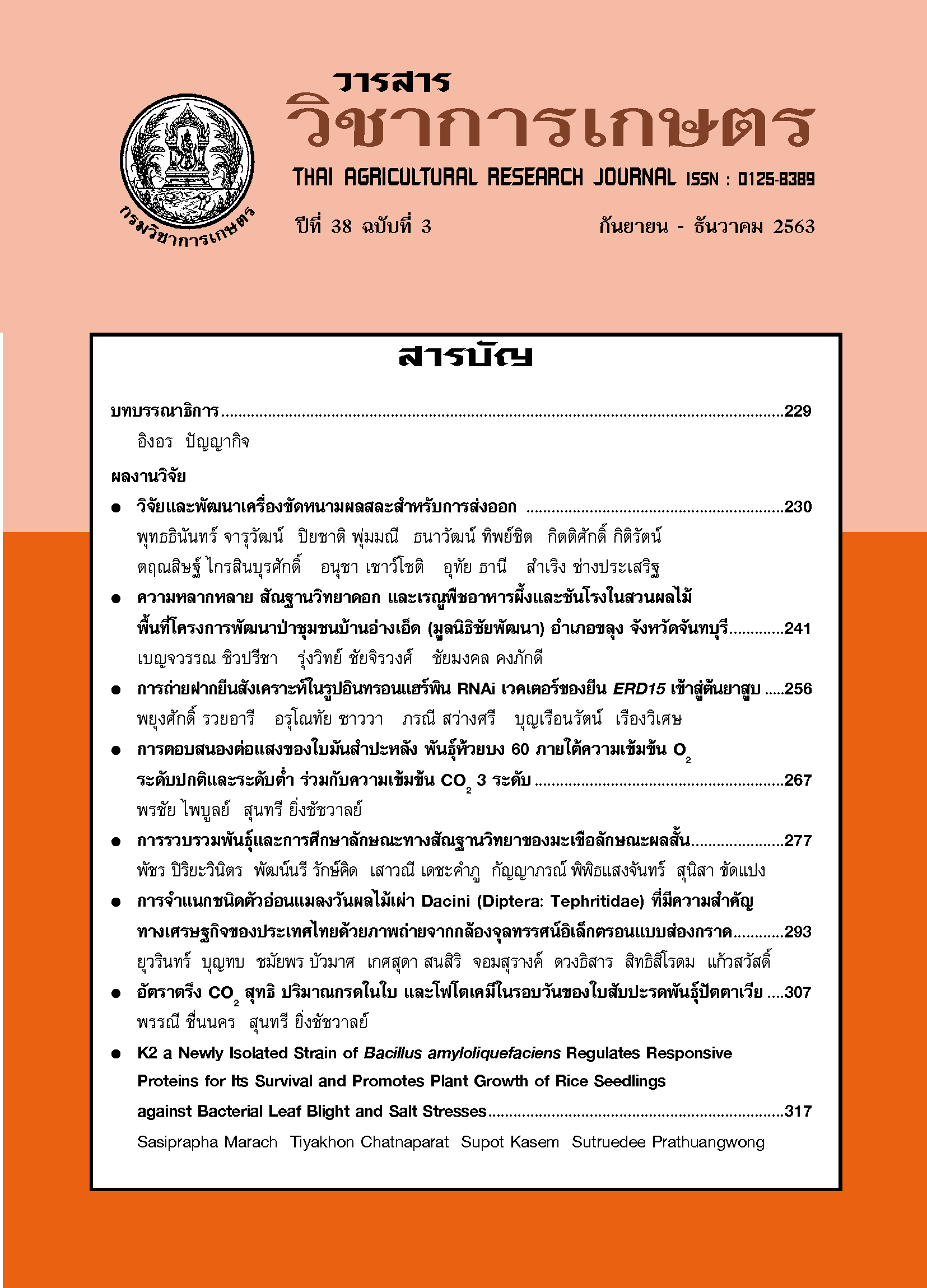การจำแนกชนิดตัวอ่อนแมลงวันผลไม้เผ่า Dacini (Diptera: Tephritidae) ที่มีความสำคัญ ทางเศรษฐกิจของประเทศไทยด้วยภาพถ่ายจากกล้องจุลทรรศน์อิเล็กตรอนแบบส่องกราด
DOI:
https://doi.org/10.14456/thaidoa-agres.2020.22คำสำคัญ:
ตัวอ่อน, แมลงวันผลไม้, จุลทรรศน์อิเล็กตรอนแบบส่องกราด, ดีเอ็นเอบาร์โค้ดบทคัดย่อ
แมลงวันผลไม้เป็นศัตรูพืชของผัก ผลไม้ ที่มีความสำคัญทางเศรษฐกิจและเป็นศัตรูพืชกักกันพืชที่สำคัญของโลก ตัวอ่อนแมลงวันผลไม้สร้างความเสียหายต่อการนำเข้าและส่งออก ตัวอ่อนแมลงวันผลไม้มีลักษณะภายนอกที่มีความคล้ายคลึงกันมาก ทำให้ยากต่อการจำแนกชนิดด้วยจุลทรรศน์ งานวิจัยนี้มีวัตถุประสงค์เพื่อศึกษาชนิดตัวอ่อนแมลงวันผลไม้ด้วยภาพถ่ายจากกล้องจุลทรรศน์อิเล็กตรอนแบบส่องกราด (Scanning Electron Microscope; SEM) เพื่อจำแนกชนิดของแมลงวันผลไม้ที่มีความสำคัญทางการเกษตรให้ถูกต้อง และเป็นที่ยอมรับระดับสากล โดยศึกษาจากตัวอ่อนแมลงวันผลไม้ที่มีความสำคัญทางเศรษฐกิจ จำนวน 6 ชนิด รวม 120 ตัวอย่าง บรรยายลักษณะสำคัญและจัดทำแนวทางตรวจวินิจฉัยตัวอ่อนแมลงวันผลไม้ 6 ชนิด ได้แก่ Bactrocera carambolae, B. correcta, B. dorsalis, B. latifrons, Zeugodacus cucurbitae และ Z. tau อย่างไรก็ตาม ควรมีการศึกษาด้านความสัมพันธ์ทางวิวัฒนาการเพิ่มเติมเพื่อสนับสนุน ข้อมูลในการจำแนกความแตกต่างในระดับชนิดของแมลงวันผลไม้ต่อไปในอนาคต
เอกสารอ้างอิง
ยุวรินทร์ บุญทบ ชมัยพร บัวมาศ เกศสุดา สนสิริ จอมสุรางค์ ดวงธิสาร และสิทธิสิโรดม แก้วสวัสดิ์. 2562ก.การศึกษาอนุกรมวิธานตัวอ่อนแมลงวันผลไม้เผ่า Dacini (Diptera: Tephritidae) ร่วมกับการใช้เทคนิค Morphometrics ในตัวเต็มวัย. หน้า 402-417 ใน การประชุมวิชาการ อารักขาพืชแห่งชาติครั้งที่ 14 ระหว่างวันที่ 12 - 14 พฤศจิกายน 2562 โรงแรมดุสิตธานีหัวหิน จังหวัดเพชรบุรี.
รัชฎาภรณ์ ชฎาภรณ์ เฉลิมวิเชียรพร สุนัดดา เชาวลิต ชมัยพร บัวมาศ อิทธิพล บรรณาการ และสิทธิศิโรดม แก้วสวัสดิ์. 2555. การศึกษาอนุกรมวิธานตัวอ่อนของแมลงวันผลไม้. หน้า 2166 - 2186. ใน: รายงานผลงานวิจัยประจำปี 2555. สำนักวิจัยพัฒนาการอารักขาพืช กรมวิชาการเกษตร. กรุงเทพฯ.
ศิริณี พูนไชยศรี ชลิดา อุณหวุฒิ พรรณเพ็ญ ชโยภาส รัตนา นชะพงษ์ลักขณา บำรุงศรี สมชัย สุวงศ์ศักดิ์ศรียุวรินทร์ บุญทบ และณัฐวัฒน์ แย้มยิ้ม. 2548. แมลงการจำแนก และการเก็บตัวอย่าง.กลุ่มกีฏและสัตววิทยา สำนักวิจัยพัฒนาการอารักขาพืช กรมวิชาการเกษตร. โรงพิมพ์ชุมนุมสหกรณ์การเกษตรแห่งประเทศไทย,จำกัด.กรุงเทพฯ 100 หน้า.
Agarwal Vasudha, Md. Abbas Ahmad and ML Agarwal. 2019. Life history traits and immature stages of Zeugodacus (Zeugodacus) tau (Walker) (Diptera: Tephritidae). J. Entomol. Zool. Stud. 7(2): 1149-1153.
Aluja, M. and A.L. Norrbom. 1999. Fruit Flies (Tephritidae): Phylogeny and Evolution of behavior. CRC Press. Florida, USA, 984p.
Armstrong, K. F. and S. L. Ball. 2005. DNA barcodes for biosecurity: invasive species identification. Philosophical Transactions of the Royal Society of London B: Biological Sciences, 360(1462): 1813-1823.
Boontop Y., MK Schutze, AR Clarke, SL Cameron, MN Krosch. 2017. Signatures of invasion: using an integrative approach to infer the spread of melon fly, Zeugodacus cucurbitae (Diptera: Tephritidae), across Southeast Asia and the West-Pacific. Biol. invasions 19 (5): 1597-1619.
Carroll, L.E., A.L. Norrbom, M.J. Dallwitz, and F.C. Thompson. 2004 onwards. Pest fruit flies of the world – larvae. Version: 9th April 2019. delta-intkey.com’.
Diamantidis, A. D., Carey, J. R., and Papadopoulus, N. T. 2008. Life-history of An Invasive Tephritid. Department of Agriculture, Crop Production and Rural Environmental, University of Thessaly. Magnisias. Greece.
Drew, R. A. I. and M. C. Romig, 2013. Tropical Fruit Flies of South-East Asia (Tephritidae: Dacinae). CAB international. 664 pp.
Drew, R. A. I. and M. C. Romig, 2017. Keys to the Tropical Fruit Flies of SouthEast Asia: (Tephritidae: Dacinae). CAB International. 496 pp.
Folmer, O., M. Black, W. Hoeh, R. Lutz, and R. Vrijenhoek. 1994. DNA primers for amplification of mitochondrial cytochrome c oxidase subunit I from diverse metazoan invertebrates. Mol. Mar. biol. Biotechnol. 3(5): 294-299.
Hall, T. A. 1999. BioEdit: a user-friendly biological sequence alignment editor and analysis program for Windows 95/98/NT. In Nucleic Acids Symposium Series. 41: 95-98.
Hendrichs, J. 2000. Use of the sterile insect technique against key insect pests. Sustainable Development International. 2: 75-79.
Krosch, M. N., M. K., Schutze, K. F., Armstrong, Y., Boontop,L. Boykin, M., T. A., Chapman, A., Englezou, S. L., Cameron, and A. R. Clarke, 2013. Piecing together an integrative taxonomicpuzzle: microsatellite, wing shape and aedeagus length analyses of Bactrocera dorsalis s.l. (Diptera: Tephritidae) find no evidence of multiple lineages in a proposed contact zone along the Thai/Malay Peninsula. Systematic Entomology. 38: 2-13.
Mousseau, T.A. and H. Dingle. 1991. Maternaleffects ininsect lifehistories. Annual Review of Entomology. 36: 511-534.
Pauls, S. U., R. J Blahnik, X. Zhou, C.T. Wardwell, and R.W. Holzentha. 2010. DNA barcode data confirm new species and reveal cryptic diversity in Chilean Smicridea (Smicridea) (Trichoptera: Hydropsychidae). J. N. AM. Benthol. Soc. 29(3): 29(3), 1058-1074.
Schutze, M.K., A. Jessup, and A.R. Clarke. 2012. Wing shape as potential discriminator of morphologically similar pest taxa with in the Bactrocera dorsalis species complex (Diptera: Tephritidae). Bull. Entomol. Res. 102: 103-111.
Steck, G. J., and S. Ekesi. 2015. Description of third instar larvae of Ceratitis fasciventris, C. anonae, C. rosa (FAR complex) and C. capitata (Diptera, Tephritidae). ZooKeys. 540: 443-466. https://doi.org/10.3897/zookeys.540.10061.
ดาวน์โหลด
เผยแพร่แล้ว
รูปแบบการอ้างอิง
ฉบับ
ประเภทบทความ
สัญญาอนุญาต
ลิขสิทธิ์ (c) 2020 วารสารวิชาการเกษตร

อนุญาตภายใต้เงื่อนไข Creative Commons Attribution-NonCommercial-NoDerivatives 4.0 International License.
วารสารวิชาการเกษตร



